Air quality
Air is a life-supporting resource that needs to be protected. In recent years air quality in Northland has become a greater issue of public concern, even though the quality of Northland's air is comparatively good by national standards.
Ambient air quality is the quality of the air that surrounds us, outside buildings or structures, and is the result of climate and topography as well as the combined effects of human activities (industrial, commercial and domestic) and natural sources.
Northland's air quality is influenced by the region's exposure to the prevailing south-westerly wind, which disperses air pollutants. This, along with the relatively dispersed population, an overall low vehicle density and sparse heavy industry, means that natural air quality in Northland is generally of a high standard.
However, regional ambient air quality monitoring has identified that at times pollutants, especially particulate matter (PM10), approach or even exceeds national air quality standards. These exceedances are restricted to specific locations and often occur under specific meteorological conditions.
What do we want for our air quality?
The operative Regional Policy Statement for Northland details existing council and community objectives for each natural and physical resource in our region. The objectives relating to air quality management are:
• The sustainable management of the air resource by avoiding, remedying, or mitigating adverse effects on the environment from the discharge of contaminants to air.
• The reduction of the region's discharges of ozone-depleting substances and the net emissions of greenhouse gases in line with National Policy Statements.
The following are the anticipated environmental results after the implementation of the policies for air quality management in the Regional Policy Statement for Northland:
• The widespread adoption of the best practicable option for all discharges to avoid, remedy or mitigate the adverse environmental effects that may result from the discharge.
• A significant reduction in the number of incidents involving pesticide use, backyard burning and other similar contaminant discharges.
• Greenhouse gas emission levels in line with government directives.
What are the issues affecting air quality?
Pollutants
The air, like any other natural resource, can be adversely affected by pollutants. Pollutants are substances that, under certain conditions, can harm human, animal or plant life. Polluted air can also interfere with the use and enjoyment of life and property by affecting visibility, causing odour, dust or smoke problems or corroding and disfiguring materials.
Pollutants of concern – such as oxides of nitrogen, reactive organic compounds, particles, carbon monoxide and sulphur dioxide – are released into the atmosphere from a range of human and natural sources. Significant sources of these pollutants include motor vehicles, industrial activities and some domestic and commercial activities. Once in the atmosphere some pollutants can then be transported throughout the region by wind and air currents.
The air quality in Northland is primarily affected by the meteorological conditions that are prevailing at the time. Warm, windy conditions tend to promote better dispersion and hence better air quality than cool, calm conditions. Consequently, air quality in Northland tends to follow a seasonal trend, improving in the summer and deteriorating during the winter months.
Environmental incidents
Since November 1993 the council has operated a system for receiving, investigating and reporting on environmental incidents 24 hours a day, seven days a week. In any given year, air incidents accounted for one third to one half of all incidents reported.
The majority of air-related incidents are distributed in five specific categories including:
• Burning or smoke nuisance
• Agrichemical spray drift
• Odour
• Industrial emissions
• Dust nuisance (as shown in Figure 50).
Figure 50: Percentage of air quality incidents according to sub-category from 2007 to 2011
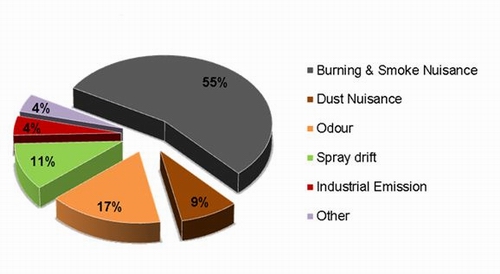
Transport
While a single, well-tuned and operated motor vehicle is unlikely to have a significant effect on air quality, collectively motor vehicles reduce air quality, particularly in urban areas. Monitoring both in New Zealand and overseas has demonstrated that vehicles emit carbon monoxide, inhalable particulate matter, oxides of nitrogen, sulphur dioxide, ozone and benzene.
Although new vehicles are more fuel efficient and emit less pollutant per kilometre travelled than older vehicles, the increasing number of vehicles on our roads, the ageing New Zealand light vehicle fleet – the average vehicle age is 12.8 years (Ministry of Transport: 2011) – and the lack of emission control checks on vehicles, largely negate the good performance of new vehicles.
Home heating
Open fires and wood burners are the primary heating source in many houses in New Zealand. Collectively these fires can reduce the air quality to the point where it can exceed relevant national environmental standards for inhalable particulate matter (PM10). Emission of particulate matter and other air pollutants increase, when people use wet, painted or treated wood, in particular. Air-related incidents falling into the home heating category are regularly reported to the council including the use of treated wood or rubbish being burnt in fireplaces.
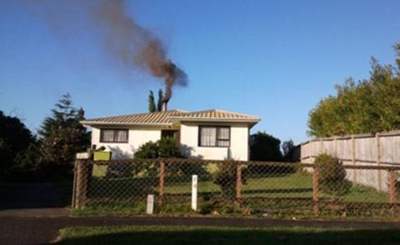 Burning toxic materials can seriously degrade air quality.
Burning toxic materials can seriously degrade air quality.
Since 1 October 2005, all new domestic fires in urban areas have been required to meet the national emission standard. This standard was introduced to reduce the amount of smoke pollution caused by domestic fires. Modern wood burners are highly energy efficient and produce fewer air pollutants. It is estimated that a total of around 1.8 tonnes of PM10 is discharged to air on an average winter day in the Whāngārei airshed. The main source during the winter is solid fuel burning for domestic home heating, which contributes to 1.3 tonnes (74%) of the PM10 emissions on an average winter day (Wilton: 2007).
Backyard burning
Disposing of refuse by burning it in the backyard is no longer considered acceptable in urban areas. The close proximity of neighbouring properties means that smoke and odours from rubbish fires frequently impact on adjoining residents. For elderly residents, very young children or people with pre-existing medical conditions such as asthma, respiratory or heart conditions, the inhalation of smoke can have serious potential effects on their health – aside from the unpleasant, acrid smoke and fumes that can result from the backyard burning of waste.
Burning and smoke nuisance incidents represent 55% of air quality related incidents reported to the council during 2007-2011 as shown in Figure 50. A comparison of the total number of air quality related incidents with the number of burning and smoke nuisance incidents reported annually during 2007-2011 is also shown in
Figure 51: Number of air quality incidents and burning smoke nuisance
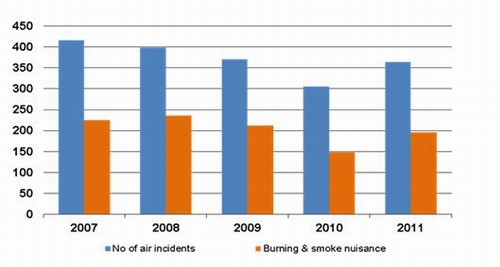
Agriculture
A range of air pollutants are released into the atmosphere from agricultural activities. Agrichemicals, dust, burning and odour are the main air pollutants released from agriculture in Northland.
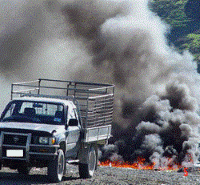 Rural fires can cause serious smoke nuisance.
Rural fires can cause serious smoke nuisance.
Other discharges
There are about 332 resource consents for the discharge of contaminants to air in Northland. Many of these consents are for small-scale sewage treatment and disposal facilities, which need appropriate controls placed on air emissions to prevent odour problems. About 80 discharge to air consents, mainly relating to industrial and commercial activities are closely monitored by the council to ensure that there are no significant adverse effects arising from the exercise of these consents.
What is our air quality like?
Clear, clean air is essential for the health and well-being of the Northland community. While poor air quality impacts on health, it also affects agricultural, horticultural and tourism industries.
The resource consent process addresses major point source discharges from industrial processes but many non-point source discharges, such as motor vehicles or domestic fires which do not require a resource consent can also collectively impact on air quality. Air quality monitoring in Northland shows that there are some areas with poorer air quality at times, especially during winter months. In winter there are periods of cold, calm weather when pollutants can build up to levels that may affect human health.
Air quality monitoring to date has shown that the Whāngārei urban area is the most likely to have air pollution episodes during winter. Air quality around busy roads, especially those subject to traffic congestion, can be degraded by pollutants emitted from motor vehicles.
Particulate matter (PM10), carbon monoxide (CO) and sulphur dioxide (SO2) are monitored on a regular basis in Whāngārei and a summary of recent results is presented in Figure 53.
Particulate matter
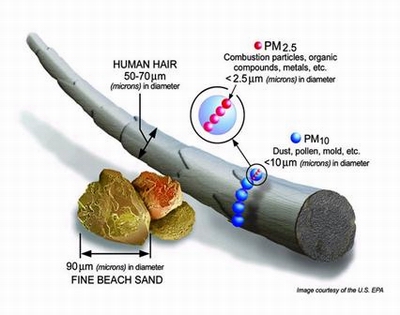
Figure 52: Particulate matter 10 size.
Particulate matter is a collective term used to describe very small solid or liquid particles such as dust, fume, smoke and mist or fog. Particulate material, which has an aerodynamic diameter of less than 10 microns, is referred to as ‘PM10' (Figure 52). PM10 in the atmosphere originates from both natural (wind-blown dust, forest fires, volcanic emissions, sea spray and pollen) and anthropogenic activities including automobile exhausts, solid fuel burning, and industrial emissions.
PM10 is small enough to be inhaled. Fine particulate matter, especially PM2.5 (<2.5 µm diameter in size), can even reach up to the human lungs and aggravate respiratory disorders. Research has shown that fine particles are more responsible for specific health effects. People most susceptible to the effects of particles include the elderly; those with existing respiratory disease such as asthma, chronic obstructive pulmonary disease and bronchitis; those with cardiovascular disease; those with infections such as pneumonia; and children.
The National Environmental Standards for Air Quality (more information on the national environmental standard can be found on the Ministry for the Environment's website at: http://www.mfe.govt.nz/laws/standards/air-quality-standards.html) set by the Ministry for the Environment for PM10 in order to protect human health is 50 g/m3 averaged over a 24 hour period (MFE 2004). PM10 is monitored in Whāngārei city using two devices. The first is a high-volume sampler operated at Water Street once every six days. A second instrument, a beta-attenuation monitor with results presented in Figure 53, operates at Robert Street.
Monitoring results for the period 2007-2011 at Robert Street showed that overall air quality was good most of the time. However, on one occasion PM10 concentrations exceeded the national environmental standards. This was on 25 September 2009 when the PM10 concentration exceeded the standards and reached 93.6 g/m3. This was due to an Australian dust storm that engulfed Sydney and Brisbane two days earlier. Many other cities in New Zealand also exceeded the national standards on that day. Higher results usually occur during the winter months, with lowest PM10 concentrations occurring during summer.
Figure 53: Daily PM10 concentration at Robert Street in Whāngārei 2007-11
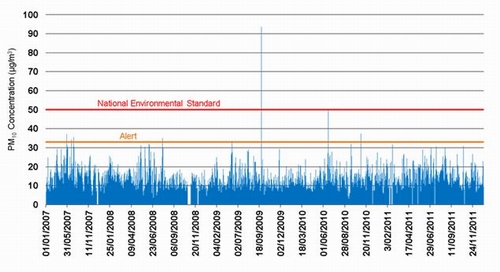
Figure 54: Environmental performance indicator for PM10 at Robert Street
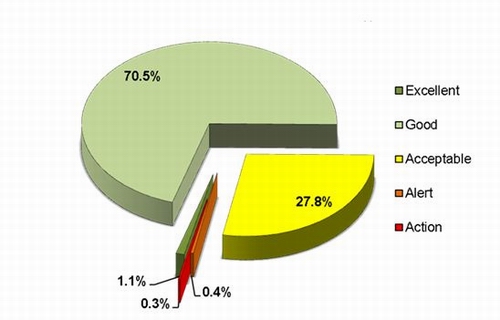
The Ministry for the Environment's Environmental Performance Indicator for PM10 measures the concentration of each pollutant against the relevant national standard value for that pollutant. To measure air quality, monitoring data is reported as the percentage of data results falling in the different air quality categories, as described in Table 14.
Table 14: Environmental Performance Indicator programme air quality categories
| Category | Measured value | Comment |
| Action | Exceeds the guideline value | Exceedances of the guideline are a cause for concern and warrant action, particularly if they occur on a regular basis. |
| Alert | Between 66% and 100% of the guideline value | This is a warning level, which can lead to exceedances if trends are not curbed. |
| Acceptable | Between 33% and 66% of the guideline value | This is a broad category, where maximum values might be of concern in some sensitive locations, but are generally at a level that does not warrant urgent action. |
| Good | Between 10% and 33% of the guideline value | Peak measurements in this range are unlikely to affect air quality. |
| Excellent | Less than 10% of the guideline value | Of little concern: if maximum values are less than a 10th of the guideline, average values are likely to be much less. |
Carbon monoxide
Carbon monoxide (CO) is a colourless and odourless gas that can be hazardous to human health. It is naturally absorbed from the lungs into the bloodstream because of the stronger affinity haemoglobin has for carbon monoxide than for oxygen. This reduces the oxygen-carrying capacity of the blood.
Carbon monoxide is a trace constituent of the atmosphere produced by both natural processes and human activities, including vehicle use and domestic burning (where incomplete combustion takes place). Places where vehicle emissions accumulate, such as traffic jams, tunnels and car parks, are locations of potentially high exposure levels.
Monitoring of CO at Robert Street has been carried out by the council since July 2010. Results have consistently been below the national standards with 92% of the data collected being within the environmental performance indicator ‘excellent' category.
Sulphur dioxide
Sulphur dioxide (SO2) is a colourless gas that reacts with ambient moisture to generate sulphuric acid aerosols (H2SO4). This transformation is the major contributor to "acid rain". Sulphur dioxide is readily identifiable by its characteristic pungent, irritating odour. Studies have shown that sulphur dioxide in combination with particulate matter poses a greater health risk than sulphur dioxide alone. High concentrations of sulphur dioxide are known to trigger the onset of chemical bronchitis and tracheitis. However, lower concentrations may trigger bronchospasm in sensitive individuals such as asthmatics.
Sulphur dioxide is produced during the combustion of fossil fuels, especially coal and oil, due to the oxidation of small quantities of sulphur compounds present within the fuel. In Northland, the major sources of sulphur dioxide are industries. These include the New Zealand Refinery at Marsden Point and other industries that oxidise sulphur as part of their production process, such as the Ballance Agri-Nutrients fertiliser manufacturing plant in Whāngārei.
The council has been monitoring SO2 in the Marsden Point airshed since the middle of 2007 and at Robert Street since July 2010. The monitoring results obtained indicated that 99% of the time SO2 concentrations were below 10% of the national standards, that is, within the environmental performance indicator ‘excellent' category.
What is being done?
National Environmental Standards
The Ministry for the Environment introduced the national standards for air quality in 2004. The regulation set ambient standards for five pollutants: carbon monoxide, sulphur dioxide, nitrogen dioxide, ozone and PM10. The standards also prohibit certain activities and set emission standards and efficiency criteria for wood burners used for household heating.
Under the national standards, regional councils must monitor these five pollutants and publicly notify any exceedances. The implementation of the standards also requires regional authorities to designate areas (airsheds) where air quality has been adversely affected.
Using research carried out by the National Institute of Water and Atmospheric Research (NIWA), the council identified five air sheds in Northland suspected of reaching or exceeding the standards. The five airsheds include Whāngārei city, Marsden Point, Kaitāia, Kerikeri and Dargaville. Maps of the airsheds' distribution are available on the council website at: www.nrc.govt.nz/NESairquality.
In 2011, the national environmental standard was updated to include the following significant amendments:
• Removing existing restrictions in the standard on industry consents for PM10 discharges.
• Introducing split target compliance dates depending on the state of air quality in each (non-complying) airshed.
• Making provision for the exclusion of exceptional events (for example, dust storms, volcanic eruptions) from counting as exceedances of the PM10 standard.
• Requiring offsets from new industries with significant PM10 discharges in polluted airsheds from September 2012.
• Prohibiting new solid-fuel open fires in homes in polluted airsheds from September 2012 (gas open fires will still be permitted).
A polluted airshed is an airshed that does not comply (that is, exceeds) the standards. None of Northland's airsheds currently meet the definition of a polluted airshed.
Regional Air Quality Plan
The Northland Regional Council produced a Regional Air Quality Plan for Northland to manage the region's air resource. It provides guidance to those using the region's air resource and contains rules that permit, control or prohibit activities which cause discharges of pollutants to air.
Marsden Point Air Quality Strategy
The council adopted Plan Change 1 (Marsden Point Air Quality Strategy) on 1 December 2008 (a copy of the change is available online at: www.nrc.govt.nz/marsdenair). The plan change was developed to implement the Marsden Point Air Quality Strategy, which was approved by the council in September 2005. The strategy is therefore considered when making decisions on air quality in the Marsden Point area.
Backyard burning
The council adopted Plan Change 2 (Backyard Burning) on 1 December 2008 (a copy of the plan change is available online at: www.nrc.govt.nz/backyardburning). The plan change was developed to reduce the number of backyard fires in the Whāngārei urban area – the Whāngārei airshed – and, in turn, to help reduce the number of burning and smoke nuisance incidents and improve overall air quality in the city.
Since the controls were introduced in December 2008, a drop in complaints was recorded from 142 incidents in 2009, to 97 incidents in 2010 but rose to 140 in 2011. With only three years of data, and the variance in the data, it is too early to make any firm conclusions on the effectiveness of the plan change.
Investigation of air incidents
All environmental incidents reported to the council's environmental hotline are recorded, investigated and reported to the council meeting every month. An assessment is made on the appropriate follow-up action to take in response to each incident, which may result in formal enforcement action being taken by the council to address the situation.
Regional council staff members assist new and existing industries with technical advice, information and experience to avoid causing problems and to assist with resolving air- related issues that already exist.
Consent monitoring
Around 80 resource consents which have permits to discharge into the air are monitored to ensure that there are no significant adverse effects arising from the exercise of these consents. In the 2007-2011 period about 85% of monitoring confirmed compliance with resource consent conditions, while 10% identified minor non-compliance which required further attention. Approximately 5% of monitoring indicated more serious non-compliance, some of which required formal enforcement action.
Emissions inventory
In order to predict the potential impact of future developments in Northland, it is important to quantify existing discharges so the additional atmospheric burden of future projects can be estimated. An air emission inventory was carried out for Whāngārei during 2006 to assess the sources and quantities of PM10 discharged to air in the Whāngārei airshed. Other contaminants such as fine particles (PM2.5), carbon monoxide, nitrogen dioxide, sulphur dioxide, volatile organic compounds and carbon dioxide were also included in the inventory.
How are we measuring up against our objectives?
The following are the anticipated environmental results listed in the Regional Policy Statement for air quality:
The widespread adoption of the best practicable option for all discharges to avoid, remedy or mitigate the adverse environmental effects that may result from the discharge
• All discharge to air consents have environmental conditions relating to best practice options associated with their consent. All point sources (consented discharges) are strictly monitored against their consent conditions and overall, their impact on air quality in Northland is significantly less than the non-point sources (permitted activities). In general, Northland has a high standard of air quality.
• The management of the dust emissions created from unsealed roads is a particular air quality issue for Northland as district councils currently have limited resources to seal gravel roads.
A significant reduction in the number of incidents involving pesticide use, backyard burning and other similar contaminant discharges
• The regional council has an effective complaints system (Environmental Hotline) and has seen a reduction in the number of agrichemical related complaints following the implementation of the Regional Air Quality Plan. The number of air incidents, while high in relation to other reported incidents, is not increasing with the majority of complaints related to back yard burning.
Greenhouse gas emission levels in line with government directives
• The greenhouse gases and ozone depleting substances sections have not been effectively implemented. This is primarily due to the overlap with central government's responsibilities for these sections, and government direction in the case of greenhouse gases, that preclude controls via discharge consent conditions. Detailed information and studies on the effects of climate change on Northland are required, particularly for effective management at the resource consent level.
